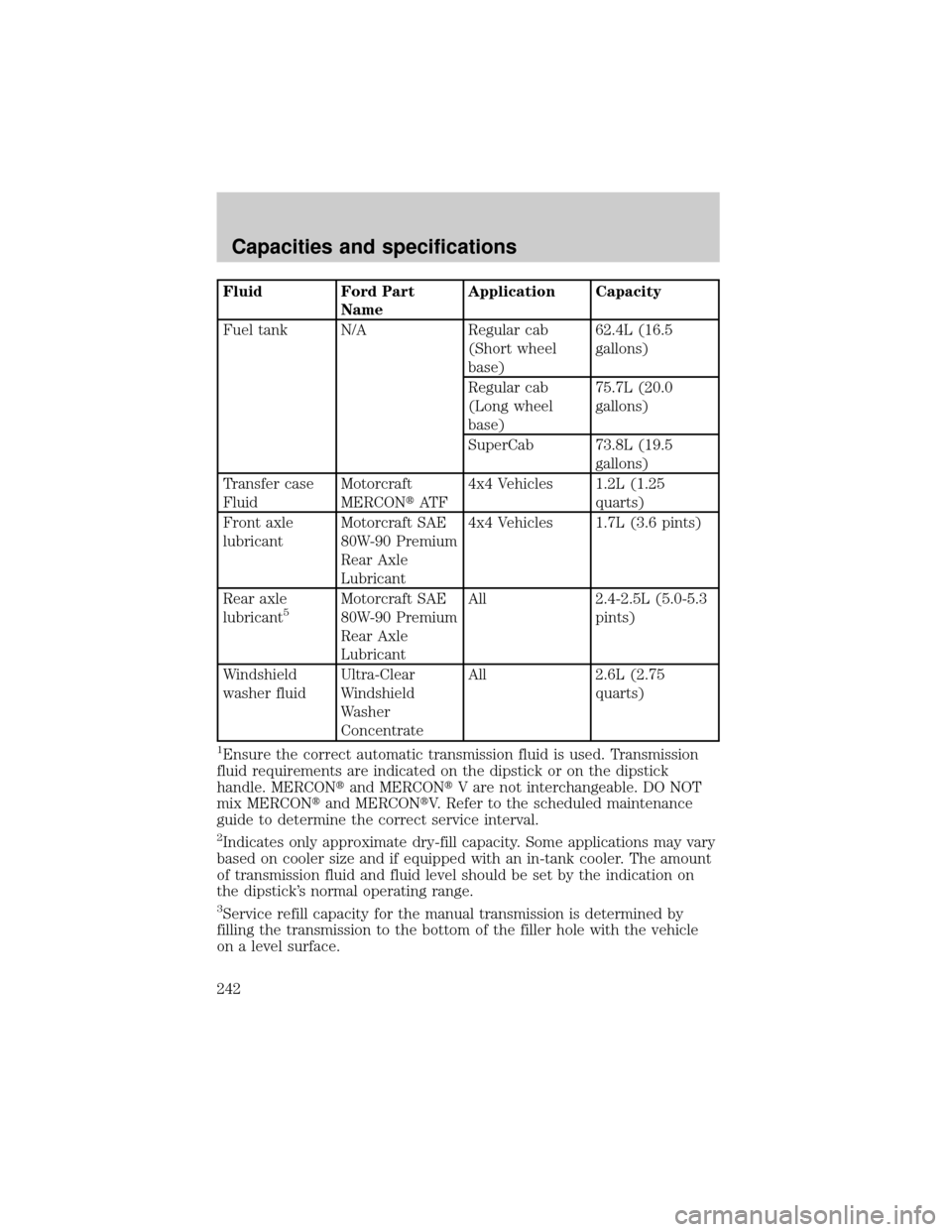Page 16 of 272
GAUGES
Fuel gauge
Displays approximately how much
fuel is in the fuel tank (when the
key is in the ON position). The fuel
gauge may vary slightly when the
vehicle is in motion or on a grade.
The ignition should be in the OFF
position while the vehicle is being
refueled. When the gauge first
indicates empty, there is a small
amount of reserve fuel in the tank.
When refueling the vehicle from
empty indication, the amount of fuel that can be added will be less than
the advertised capacity due to the reserve fuel.
The FUEL DOOR icon and arrow indicates which side of the vehicle the
fuel filler door is located.
EF
Instrumentation
16
Page 222 of 272

ESSENTIALS OF GOOD FUEL ECONOMY
Measuring techniques
Your best source of information about actual fuel economy is you, the
driver. You must gather information as accurately and consistently as
possible. Fuel expense, frequency of fillups or fuel gauge readings are
NOT accurate as a measure of fuel economy. We do not recommend
taking fuel economy measurements during the first 1 600 km (1 000
miles) of driving (engine break-in period). You will get a more accurate
measurement after 3 000 km±5 000 km (2 000 miles-3 000 miles).
Filling the tank
The advertised fuel capacity of the fuel tank on your vehicle is equal to
the rated refill capacity of the fuel tank as listed in theRefill capacities
section ofthe Capacities and specificationschapter.
The advertised capacity is the amount of the indicated capacity and the
empty reserve combined. Indicated capacity is the difference in the
amount of fuel in a full tank and a tank when the fuel gauge indicates
empty. Empty reserve is the small amount of fuel remaining in the fuel
tank after the fuel gauge indicates empty.
The amount of usable fuel in the empty reserve varies and should
not be relied upon to increase driving range. When refueling your
vehicle after the fuel gauge indicates empty, you might not be
able to refuel the full amount of the advertised capacity of the
fuel tank due to the empty reserve still present in the tank.
For consistent results when filling the fuel tank:
²Turn the engine/ignition switch to the off position prior to refueling,
an error in the reading will result if the engine is left running.
²Use the same filling rate setting (low Ð medium Ð high) each time
the tank is filled.
²Allow no more than 2 automatic click-offs when filling.
²Always use fuel with the recommended octane rating.
²Use a known quality gasoline, preferably a national brand.
²Use the same side of the same pump and have the vehicle facing the
same direction each time you fill up.
²Have the vehicle loading and distribution the same every time.
Your results will be most accurate if your filling method is consistent.
Maintenance and care
222
Page 242 of 272

Fluid Ford Part
NameApplication Capacity
Fuel tank N/A Regular cab
(Short wheel
base)62.4L (16.5
gallons)
Regular cab
(Long wheel
base)75.7L (20.0
gallons)
SuperCab 73.8L (19.5
gallons)
Transfer case
FluidMotorcraft
MERCONtAT F4x4 Vehicles 1.2L (1.25
quarts)
Front axle
lubricantMotorcraft SAE
80W-90 Premium
Rear Axle
Lubricant4x4 Vehicles 1.7L (3.6 pints)
Rear axle
lubricant
5Motorcraft SAE
80W-90 Premium
Rear Axle
LubricantAll 2.4-2.5L (5.0-5.3
pints)
Windshield
washer fluidUltra-Clear
Windshield
Washer
ConcentrateAll 2.6L (2.75
quarts)
1Ensure the correct automatic transmission fluid is used. Transmission
fluid requirements are indicated on the dipstick or on the dipstick
handle. MERCONtand MERCONtV are not interchangeable. DO NOT
mix MERCONtand MERCONtV. Refer to the scheduled maintenance
guide to determine the correct service interval.
2Indicates only approximate dry-fill capacity. Some applications may vary
based on cooler size and if equipped with an in-tank cooler. The amount
of transmission fluid and fluid level should be set by the indication on
the dipstick's normal operating range.
3Service refill capacity for the manual transmission is determined by
filling the transmission to the bottom of the filler hole with the vehicle
on a level surface.
Capacities and specifications
242
Page 271 of 272

Item Information
Required fuel Unleaded fuel only - 87 octane
Fuel tank capacity (Regular
cab-Short wheel base)62.4L (16.5 gallons)
Fuel tank capacity (Regular
cab-Long wheel base)75.7 (20.0 gallons)
Fuel tank capacity (SuperCab) 73.8L (19.5 gallons)
Engine oil capacity (includes filter
change)-2.3L I4 engine3.8L (4.0 quarts). Use Motorcraft
SAE 5W-20 Super Premium Motor
Oil, Ford specification
WSS-M2C153-H.
Engine oil capacity (includes filter
change)- 3.0L V6 engines4.3L (4.5 quarts). Use Motorcraft
SAE 5W-20 Super Premium Motor
Oil, Ford specification
WSS-M2C153-H.
Engine oil capacity (includes filter
change)- 4.0L V6 engine4.7L (5.0 quarts). Use Motorcraft
SAE 5W-30 Super Premium Motor
Oil, Ford specification
WSS-M2C153-G.
Tire size and pressure Refer to the Certification Label on
inside of driver's door.
Hood release Pull handle under the left side of
the instrument panel.
Coolant capacity-2.3L I4 with
manual transmission
110.0L (10.5 quarts)
Coolant capacity-2.3L I4 with
automatic transmission
19.7L (10.2 quarts)
Coolant capacity-3.0L V6 with
manual transmission
114.3L (15.1 quarts)
Coolant capacity-3.0L V6 with
automatic transmission
114.0L (14.8 quarts)
Coolant capacity-4.0L V6 with
manual transmission
113.0L (13.7 quarts)
Coolant capacity-4.0L V6 with
automatic transmission
112.5L (13.2 quarts)
Filling station information
271